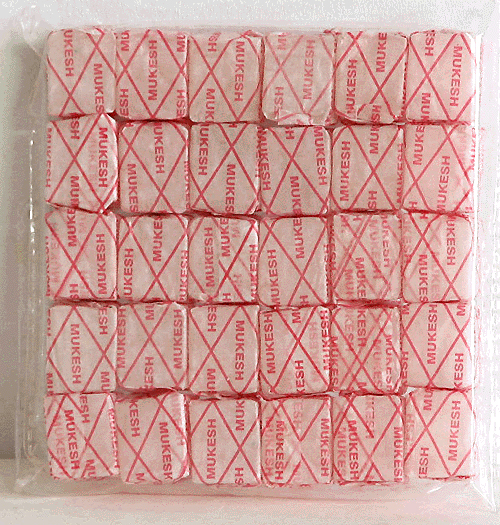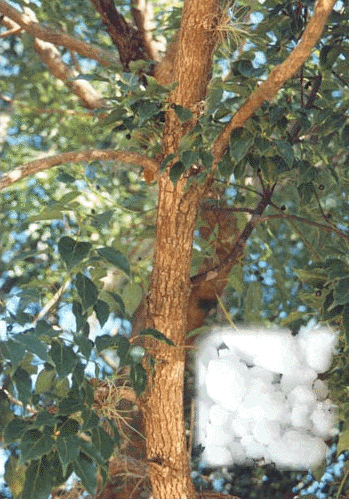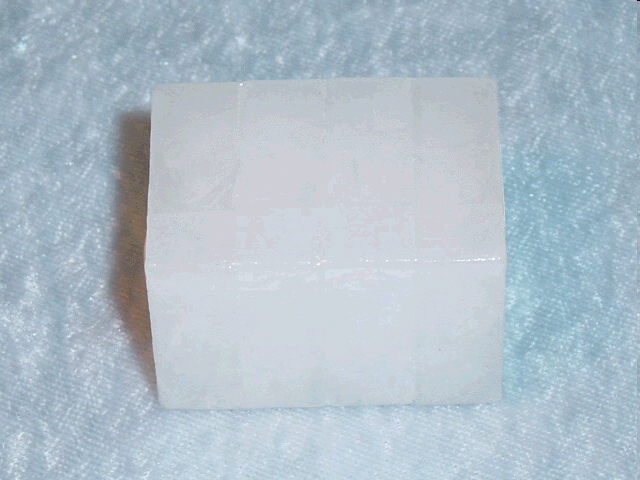
|
|
|
|
BY: SUN STAFF

Cubes of Camphor May 06, 2010 — CANADA (SUN) — A journey through India: border to border, bhoga to prasadam. Today, we begin a three-part series on what is perhaps the least often used, yet the most distinctive of all prasadam ingredients -- karpura, or camphor. Known by many names, camphor is an important part of Vaisnava culture, both in cooking and in deity worship. This highly aromatic substance is also referred to many places in sastra in descriptions of various qualities of Sri Krsna and Srimati Radharani.
There are numerous varieties of camphor. The purest forms are considered cooking grade, or edible, while the less refined forms are typically burned during aarti. The lesser grade of camphor is used for burning in aarti lamps called kapur or eka-dipa, but the edible camphor is best used for deity worship, because it's a finer grade. Camphor's use in deity worship is described in Srimad Bhagavatam 11.27.30-31: "The worshiper should bathe the Deity every day, as opulently as his assets permit, using waters scented with sandalwood, usira root, camphor, kunkuma and aguru." Pure edible camphor is generally a crystalline compound that looks like coarse salt. It's usually found in the form of small, hard blocks, but is sometimes loose or even powdered. Camphor is obtained by a process of steam distillation of the aromatic leaves, branches, roots and wood of a few types of evergreen trees.

Camphor Laurel (cinnamomum camphora) The cinnamomum camphora, or Camphor Laurel, is a large evergreen that grows throughout Southeast Asia, China and Japan. Borneo and Taiwan are famous areas for growing camphor trees. In the forests of Borneo there are several trees very similar to Camphor Laurel that are used to produce edible camphor, including dryobalanops aromatica and ocotea usambarensis. In Asia, the crystals are harvested from Camphor Basil. Camphor is also synthetically produced from oil of turpentine. When purchasing camphor for cooking, be very careful that the product is labeled "edible camphor", as there are many types of synthetic camphor available on the market, such as camphor blocks or mothballs, which can be extremely poisonous. The word 'camphor' derives from the Sanskrit word karpoor, from the French camphre, from camfora in Medieval Latin, and from kafur in Arabic. Among the many Indian names for camphor are karpoor, kapur, kacha (kachha), pachakarpooram, and pachai kalpooram. Camphor is often confused with another aromatic called kewra, which is extracted from the flowers of Screwpine (pendanus odoratissimus). In Hindi, the term kewra is sometimes translated as camphor, but it is actually describing the Screwpine extract, kewra. Barus was a port on the western coast of Sumatra where foreign traders came to buy camphor, hence in Malay, the place became known as Kapur Barus. Historical mention of camphor is found in the records of trade along the west coast of Borneo. In a manuscript describing the history of the Sung Dynasty (960-1279 A.D.), we read an interesting description of a spot in Borneo situated 40 days from Champa and 45 days from Java. In the year 977, there is a record of gifts delivered as tribute by the king of Borneo, Hiang-ta, who sent three of his envoys to the court of China. Among the articles delivered were: 'One cati of camphor in large pieces; eight catis camphor of the second sort; eleven catis of the third sort; twenty catis small grained camphor; and twenty catis of the last sort, one cati being equal to twenty taels Chinese weight (about 0.8 kilogram). The remaining tribute was five boards of camphor wood, a hundred tortoise shells, three trays of sandalwood, and six elephant tusks.'

Camphor Considered a valuable commodity worldwide, it's not surprising that both the fragrance and flavor of camphor are used to describe some of Radha and Krsna's personal qualities, like Their smile. Interestingly, while camphor might typically be described as pungent or aromatic, it is not generally thought of as being sweet, although that is the quality often compared to the Lord's attributes. Of course, when camphor is combined with sugar or milk, it becomes sweet, and when Radha and Krsna are together, the sweetness increases. Caitanya-caritamrta describes Radha and Krsna's camphor-like qualities: Madhya Lila 8.170: "Srimati Radharani's personal beauty is the reddish powder known as kunkuma, Her affection for Her associates is sandalwood pulp, and the sweetness of Her smile is camphor. All these, combined together, are smeared over Her body." Antya 15.23: "Krsna's lips are so sweet when combined with the camphor of His gentle smile that they attract the minds of all women, forcing them to give up all other attractions. If the sweetness of Krsna's smile is unobtainable, great mental difficulties and lamentation result. That sweetness is the only wealth of the gopis of Vrndavana." Antya 17.44: "Krsna's speech is far sweeter than nectar. Each of His jubilant words is full of meaning, and when His speech mixes with His smile, which is like camphor, the resultant sound and the deep meaning of Krsna's words create various transcendental mellows." Antya 19.94: "Krsna's eyes, navel and face, hands and feet are like eight lotus flowers on His body. From those eight lotuses emanates a fragrance like a mixture of camphor and lotus. That is the scent associated with His body." In addition to sastric descriptions of the Lord's personal qualities being like camphor, there are other passages comparing various transcendental aspects of bhakti to camphor: Madhya 14.177-78: "There are eight symptoms of ecstatic love on the platform of transcendental jubilation, and when they are combined and tasted by Krsna, the Lord's mind is completely satisfied. Indeed, they are compared to a combination of yogurt, candy, ghee, honey, black pepper, camphor and cardamom, which, when mixed together, are very tasty and sweet." Madhya 19.181-2: "When the higher standard of ecstatic love is mixed with the symptoms of sattvika and vyabhicari, the devotee relishes the transcendental bliss of loving Krsna in a variety of nectarean tastes. These tastes are like a combination of yogurt, sugar candy, ghee [clarified butter], black pepper and camphor and are as palatable as sweet nectar. Madhya 23.49: "Yogurt mixed with sugar candy, black pepper and camphor is very palatable and tasty. Similarly, when permanent ecstasy mixes with other ecstatic symptoms, it becomes unprecedentedly tasty." Madhya 25.277: "The pastimes of Sri Caitanya Mahaprabhu are full of nectar, and the pastimes of Lord Krsna are like camphor. When one mixes these, they taste very sweet. By the mercy of the pure devotees, whoever tastes them can understand the depths of that sweetness." Although our focus in this segment will be primarily on the use of camphor as an ingredient for cooking, all these transcendental descriptions certainly increase our appreciation for the stuff. Tomorrow we'll begin to look at the many recipes for camphor's use, not only in traditional sweetballs and sweet rice preparations, but also in beverages, breads and sabjis.
| |